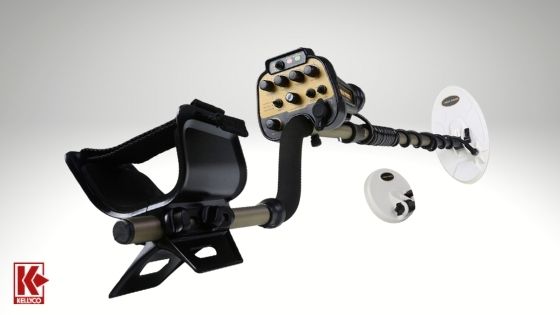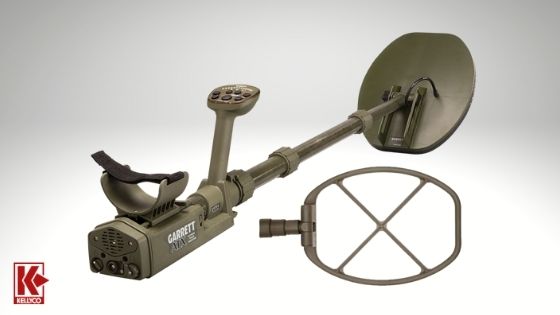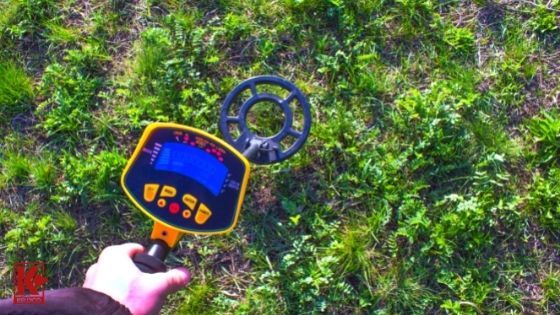Metal Detecting Tips: Fine-Tuning Your Detector
Published by Carolyn Yohannes on 03/29/20
Knowing the best metal detecting tips to fine-tune your detector is key for optimal performance. Luckily, our team here at Kellyco has many years of experience in just about every type of soil imaginable. Read on for some of our favorite metal detecting tips and tricks to get the most out of your metal detector!
Different Types of Metal Detector Frequencies
When it comes to getting the most out of metal detecting, the first decision you need to make is what type of metal detector to buy. Metal detectors use two different types of frequencies: Very Low Frequency (VLF) and Pulse Induction (PI).
Very Low Frequency (VLF)

Nokta Makro AU Gold Finder Metal Detector
This type of metal detector uses two coils. One sends and the other receives to detect targets in the ground. The sender coil creates a magnetic field that reacts to metal objects and a current is formed when a target is found. The receiver coil takes the signal and amplifies it to be heard through a speaker or headphones. Many detectors can even translate the signal into a number based on how strong the magnetic current is.
Metal detectors that use VLF technology can give information back on targets. The control box is where the magic happens with this type of detector. It interprets the signal and turns it into simple visual and audio cues. Depending on how much work goes into the interface and controls, you can:
- Ignore targets you don’t want to dig
- See about how deep a target is
- Change the sensitivity
Most detectors are set up for specific types of hunting. For example, the settings on gold detectors like the Nokta Makro AU Gold Finder take into account the hot rocks and ground that are encountered in a gold field. Some of the newer detectors, like the Garrett AT Max or Minelab Equinox Series, are set up to be used in multiple soil types with preset programs that change settings fairly easily.
Pulse Induction (PI)
While the previous types of metal detector technologies used two coils working together, PI can use one or more coils in a much different way. The coil sends out bursts of electronic currents that bounce back when it hits a metal object. The best way to think about PI is that it’s like a bat’s echolocation. There is no way to tell the difference between targets — just that there is one.

Garrett ATX Pro Deepseeker Metal Detector
The greatest advantage of PI frequency detectors is that they search much deeper than the VLF. A detector like the Garrett Deepseeker will give you the best results if you plan on searching for very deep targets. Many beach and underwater detectors use PI as well. It is very stable and reliable at finding targets even in the salt found in beach water and sand.
There are many metal detectors on the market for a wide range of needs and experience levels. It’s easy to get overwhelmed or choose one that does more than you need it to. Finding the detector that fits your needs boils down to choosing the features you need. This is why we have a team of metal detecting experts who can help match you up to the right detector and help you with even more metal detecting tips. Give us a call and we would be more than happy to assist you!
Read more about VLF vs. PI here.
Metal Detecting Tips — Getting Extra Depth with Your Metal Detector
Now that we’ve covered the basics of metal detector frequencies, let’s look at some practical metal detecting tips you can follow to get extra depth. This can help you find older relics as well as targets that other detectorists may have missed. Practice these tricks in your test garden and get comfortable with them before going out into the field.
Turn Up the Sensitivity Setting
Increasing sensitivity will definitely help you detect at greater depths – under the right circumstances. The thing with sensitivity is that it’s a double-edged sword. It can actually reduce your target identification capability if you run it too high. Doing so may drive you nuts with alerts in heavy iron or very trashy spots.
Swing Closer to the Ground
Swing your detector’s coil as close to the ground as you can to increase the depth at which you’re detecting. This may seem like a rather obvious tip, but you would be surprised how many detectorists lose sight of how high their coils are when they are paying more attention to their swinging motion.
Reduce Discrimination Setting
Often, deeply buried, desirable targets are read wrong by detectors for numerous reasons. You won’t hear or see the false readings if you are running too much discrimination. When you:
- Reduce the discrimination to the lowest you can stand (you will hear alerts for everything)
- Examine every deep signal closely
- Watch for a jump into the desirable range as you swing
Then you may just be over a deeply buried target and not just another nail. Maybe.
Know Your Detector’s Settings
It’s important that you read and know your detector’s instruction manual thoroughly. Your detector may have particular settings that will allow you to find deep targets.
Try Different Swing Speeds
The readings your detector emits may be different depending on how quickly you are swinging it. For example, some detectors get a much clearer reading on deep targets when it is swung moderately fast, rather than a slow swing. This is one of the reasons that practicing in a test garden is so helpful – you can experiment with different speeds to see how your machine responds.
Use Headphones
If you are not using headphones with your detector, then you are almost certainly missing some deep targets. You are likely distracted by outside noise and don’t hear quick or faint alerts.

Garrett MS-3 Z Lynk Wireless Headphones
Additionally, when you’re hunting a site where you suspect there are deeply buried items, try covering upyour detector’s display and going by sound only. Sometimes, deep targets will signal with only very subtle changes in the audio. Not seeing your display will force you to listen more carefully to the sounds coming from your detector. This is another reason that you need to wear a good set of headphones when you are trying to locate deeply buried targets.
Consider Other Variables
There’s more to getting added depth than what your metal detector can do. The best detectorists take time to consider what’s going on beneath their feet. This includes:
- How long the target has been buried – different metals corrode at different rates. The longer an item has been buried, the longer the ground chemicals have had a chance to “eat away” at the metal.
- The size of the item – the bigger the target, the deeper it can be detected.
- The object’s shape and position – an object that is lying flat will be detectable at greater depths than one that is buried vertically.
Getting extra depth with your metal detector is a fantastic way to make seemingly hunted out-sites productive again. Being knowledgeable of your metal detector’s capabilities and understanding target positioning are key to a successful hunt. All it takes is patience and practice, and following these metal detecting tips!
Metal Detecting Tips – Understanding Ground Balance
In the above section, we looked at some simple steps detectorists of all levels can take to get deeper readings. But what if the soil itself is preventing your metal detector from accurately taking deep readings?
>Soils in different areas contain varying levels of metallic minerals which can affect detection depth. That means that you could be missing valuable finds if you don’t know the composition of the ground that you are searching. One way to minimize the effects that ground minerals cause is by using ground balancing as it allows your detector to limit signals from ground minerals.
Mineralized Soil and Ground Balance
Ground balance is important because concentrated ground mineralization may cause signals that tell you there is a target when there really isn’t. The feedback from mineralization can also hide good targets and negatively affect depth detection. A ground balance setting on your detector will help minimize the loss of depth and the false signals.
Ground balance is a variable setting that increases your machine’s detection depth in mineralized soil. The soil may contain fine iron particles in areas with red earth or salts found in beach sand. These types of minerals cause your detector to react as if it found a target. That means that the effect of mineralization can mask smaller items. When the ground balance is corrected, it removes the responding mineralization signals so that you can hear target signals clearly.
Ground Balance Configurations

Ground Balance Configurations
Most “starter” metal detectors (ones that have fewer adjustable settings and are aimed at novices) have a ground balance setting that is set at the factory and cannot be adjusted by the user. These are good starter machines and they will do well in mild soils, but they will likely struggle in soils that have higher levels of mineralization.
There are three main types of ground balanced aside from fixed:
- Manual Ground Balance – this allows you to adjust the ground balance to minimize the amount of ground signal that’s heard.
- Automatic Ground Balance – your detector will automatically determine the best ground balance setting. This type is much more accurate than manually setting ground balance, plus it’s quicker and easier.
- Tracking Ground Balance – your detector will continuously adjust the ground balance setting as you are detecting.
A detector that has manual ground balance will have buttons or knobs that allow you to lower or raise the ground balance based on the type of soil you are searching. Once you set the ground balance, it will not change until you adjust it again. Having the ability to tweak the ground balance and operate it a little higher or a little lower can be beneficial sometimes. A detector that offers you the option to switch between manual and automatic ground balance is really the way to go.
Know the Area Where You Will Be Hunting
It is worth doing research to see what kind of metal detector is best for the area and type of targets you plan on hunting. Metal detecting forums, Facebook groups, and metal detecting clubs are all great places to start and offer many of their own metal detecting tips. They can tell you if you should be looking at a specialized detector for the beach or gold fields, or if an all-purpose detector would be better.
Keep in mind that ground mineralization can be inconsistent. In some areas, you may find a dramatic difference in the ground mineralization within just a couple of feet. You may find yourself having to adjust the ground balance setting often in order to not lose any depth while hunting.
Final Word
It doesn’t take much to get the most out of your metal detector if you follow these metal detecting tips. Both beginner and experienced detectorists will benefit from choosing the right kind of metal detector frequency, as well as using some simple tricks to get the most depth possible. Those dealing with heavy mineralization will benefit from adjusting their ground balance configurations. Following these steps will ensure many successful hunts for years to come.
